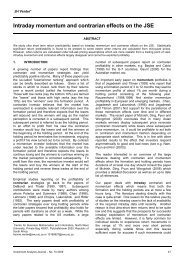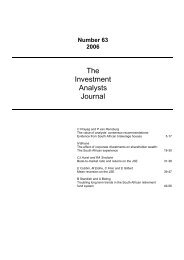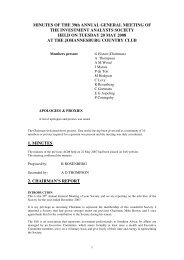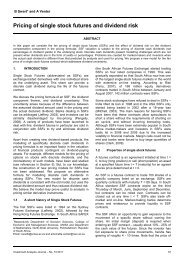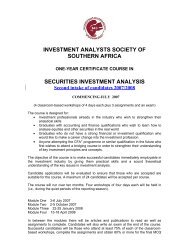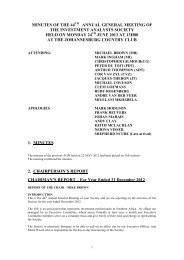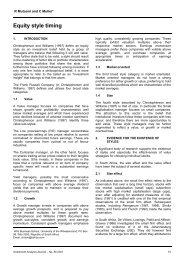The stock market reaction to criticism of corporate governance ...
The stock market reaction to criticism of corporate governance ...
The stock market reaction to criticism of corporate governance ...
You also want an ePaper? Increase the reach of your titles
YUMPU automatically turns print PDFs into web optimized ePapers that Google loves.
<strong>The</strong> <strong>s<strong>to</strong>ck</strong> <strong>market</strong> <strong>reaction</strong> <strong>to</strong> <strong>criticism</strong> <strong>of</strong> <strong>corporate</strong> <strong>governance</strong> practices <strong>of</strong> companies listed on the JSE<br />
same industry performed as poorly as or worse than<br />
the -22,94%. For the 36-month holding period, the<br />
abnormal return deteriorated <strong>to</strong> -25,69%, but with a p-<br />
value, that is not statistically significant.<br />
Daniel et al. (1997) have documented strong<br />
relationships among size, BV/MV, and future returns<br />
for companies listed on the NYSE. We followed the<br />
procedure recommended by Daniel et al. <strong>to</strong> control for<br />
the potential impact <strong>of</strong> these characteristics on future<br />
returns. We replicated the analysis with a set <strong>of</strong><br />
matching companies that were close <strong>to</strong> the sample<br />
companies in terms <strong>of</strong> size and BV/MV. <strong>The</strong>n a control<br />
company was randomly selected for each sample<br />
company such that the control company was <strong>of</strong> the<br />
same size and BV/MV as the sample company. <strong>The</strong><br />
buy-and-hold return <strong>of</strong> this control portfolio was then<br />
computed. This procedure was then repeated 300<br />
times with the replacement <strong>to</strong> generate an empirical<br />
distribution <strong>of</strong> buy-and-hold returns.<br />
<strong>The</strong> results for the sample <strong>of</strong> Botha criticised<br />
companies measured against the characteristicsmatched<br />
control group are reported in Panel B, <strong>of</strong><br />
Table 2. <strong>The</strong> results are similar <strong>to</strong> those reported in<br />
Panel A representing industry matched control group.<br />
<strong>The</strong> one-year abnormal returns <strong>of</strong> the sample<br />
companies were -13,41% with a p-value <strong>of</strong> 0,051. <strong>The</strong><br />
two-year results are not as significant as those in<br />
Panel A.<br />
Overall, the results show that the valuation effect <strong>of</strong><br />
Botha’s <strong>criticism</strong> <strong>of</strong> <strong>corporate</strong> <strong>governance</strong> practice is<br />
not restricted <strong>to</strong> the time period immediately<br />
surrounding the day <strong>of</strong> publication in the financial<br />
press. <strong>The</strong> <strong>market</strong> continues <strong>to</strong> adjust <strong>to</strong> the<br />
information at least for one year and possibly for two<br />
years after publication <strong>of</strong> the articles. Because the<br />
significant negative abnormal returns continue for two<br />
post-publication years, we conclude that the initial<br />
negative <strong>reaction</strong> at the time <strong>of</strong> the article’s publication<br />
was an under-<strong>reaction</strong>.<br />
It is not suggested that Botha was the cause <strong>of</strong> the<br />
downward effect on the share prices. His <strong>criticism</strong>s <strong>of</strong><br />
the companies concerned seem <strong>to</strong> have triggered a reevaluation<br />
by the <strong>market</strong>, and his analysis apparently<br />
helped move prices <strong>to</strong>wards the fundamentals. If<br />
Botha had not criticised these companies, someone or<br />
something else would in time have brought about a<br />
revaluation <strong>of</strong> these shares. However, without Botha’s<br />
<strong>criticism</strong>, it would have apparently taken longer for the<br />
information <strong>to</strong> be impounded in the share prices.<br />
4.2 Operating performance<br />
In an effort <strong>to</strong> understand the source <strong>of</strong> the abnormal<br />
share price performance <strong>of</strong> the companies in our<br />
sample, we investigated their operating performance<br />
around the time <strong>of</strong> publication <strong>of</strong> the articles. In effect,<br />
we examined the possibility that Botha could foresee a<br />
decline in pr<strong>of</strong>itability arising from his <strong>criticism</strong> <strong>of</strong> the<br />
companies concerned. We first report results from an<br />
examination <strong>of</strong> operating performance. We then briefly<br />
present changes in Altman’s Z-scores that corroborate<br />
the operating performance findings.<br />
A problem in examining operating performance is the<br />
identification <strong>of</strong> an appropriate metric. In some<br />
instances, such as pooling-<strong>of</strong>-interest accounting,<br />
excessive write-<strong>of</strong>fs related <strong>to</strong> acquired in-process<br />
research and development, and so forth, can allow<br />
companies <strong>to</strong> report higher net income numbers after<br />
mergers or acquisitions. Also, the use <strong>of</strong> varying<br />
accounting treatment for similar transactions that result<br />
in vastly different reported income (e.g., capitalising<br />
versus expensing) limits the usefulness <strong>of</strong> net income<br />
as a performance metric. <strong>The</strong>refore, we used the ratio<br />
<strong>of</strong> operating income before depreciation and<br />
amortisation <strong>to</strong> <strong>to</strong>tal assets as the measure <strong>of</strong><br />
operating performance <strong>of</strong> the companies. This ratio<br />
provides a relatively clean measure <strong>of</strong> operating<br />
performance and is less likely than net income <strong>to</strong> be<br />
affected by accounting issues <strong>to</strong> measure the<br />
performance <strong>of</strong> the sample <strong>of</strong> companies criticized by<br />
Botha.<br />
Table 3 presents an analysis <strong>of</strong> the operating<br />
performance <strong>of</strong> the companies in the sample around<br />
the period <strong>of</strong> the publication in the financial press in<br />
response <strong>to</strong> <strong>criticism</strong> by Botha. We defined operating<br />
performance as return on assets (ROA), computed as<br />
the ratio <strong>of</strong> operating earnings <strong>to</strong> <strong>to</strong>tal assets. To<br />
abstract from economy-wide or industry-wide effects,<br />
we also used industry-adjusted numbers. <strong>The</strong> industry<br />
benchmark was defined as the median operating<br />
performance <strong>of</strong> all companies operating in the same<br />
industry as the sample company.<br />
Panel A, <strong>of</strong> Table 3 shows raw and industry-adjusted<br />
mean and median ROAs for each year up <strong>to</strong> Year +3<br />
relative <strong>to</strong> the publication year. Year -1 is the last year<br />
for which data were available prior <strong>to</strong> publication <strong>of</strong> the<br />
article, and Year +1 is the first year for which data<br />
were available after the publication <strong>of</strong> the article. <strong>The</strong><br />
results in Panel A (raw and industry-adjusted means<br />
and medians) show that, on average, the companies’<br />
operating performance declined from pre-<strong>to</strong>-post<br />
publication years. <strong>The</strong> mean operating performance <strong>of</strong><br />
the sample companies declined from 14,27% in Year -<br />
3 <strong>to</strong> 8,73% in Year +3.<br />
Panel B <strong>of</strong> Table 3 reports the change in postpublication<br />
ROA relative <strong>to</strong> Year -1. <strong>The</strong> results for raw<br />
as well as industry-adjusted ROA show both the mean<br />
and the median ROAs in the post-publication years <strong>to</strong><br />
be significantly lower than ROAs in the year prior <strong>to</strong><br />
publication. Overall, the decline in operating<br />
performance is large (economically meaningful) and<br />
statistically significant.<br />
6 Investment Analysts Journal – No. 72 2010




